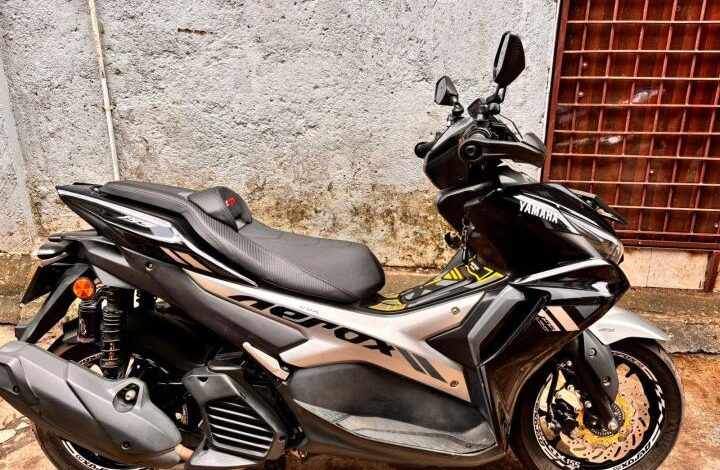In the world of performance scooters, one name consistently stands out, creating a cult-like following from the streets of Bangkok to the boulevards of Europe: the Yamaha Aerox. It’s a scooter that defies convention, blending the practicality of daily commuting with the heart and soul of a sportbike.
Whether you’re a seasoned rider looking for a nimble urban weapon or a newcomer intrigued by the hype, this is your ultimate guide to everything Yamaha Aerox.
What is the Yamaha Aerox?
At its core, the Yamaha Aerox is a maxi-style, liquid-cooled 4-stroke scooter. But to label it just a “scooter” is a dramatic understatement. Since its inception in the 1990s, the Aerox has evolved into a performance-oriented machine, renowned for its sharp styling, agile handling, and punchy engine. It’s the scooter for those who believe the journey should be as thrilling as the destination.
A Legacy of Performance: A Brief History
The Aerox story began in 1997 with the Aerox 50, a scooter that immediately stood out with its sporty aesthetics and two-stroke engine. It quickly became a favorite for customization and tuning. Over the years, Yamaha has continuously refined the Aerox, most notably with the launch of the fourth-generation model (Aerox 4) and the current global version, the Aerox R-series, which features a more aggressive design, a liquid-cooled engine, and Yamaha’s Variable Valve Actuation (VVA) technology.
Key Features & What Makes It Special
So, what separates the Aerox from a sea of commuter scooters?
- The Engine: Heart of a Champion
The modern Aerox is powered by a 155cc, liquid-cooled, single-cylinder SOHC engine with VVA. This technology is a game-changer:
- VVA (Variable Valve Actuation): Essentially, it gives you two engines in one. At lower RPMs, it focuses on fuel efficiency and smooth power delivery. At higher RPMs, a second set of cam profiles kicks in, boosting top-end power for exhilarating acceleration and a higher top speed. This results in a scooter that is both tractable in city traffic and a blast on open roads.
- Chassis and Handling: Built for the Corners
The Aerox features a rigid diamond-type frame, more akin to a motorcycle than a typical scooter. Coupled with upside-down (USD) front forks and a linked rear shock, this setup provides exceptional stability and feedback. It inspires confidence when leaning into corners, making it one of the best-handling scooters in its class.
- Aggressive and Athletic Styling
With its sharp lines, LED headlights and tail lights, and muscular bodywork, the Aerox looks fast even when standing still. The “R” version often includes bold graphics, a sporty belly pan, and a sleek, minimalist tail section that screams performance.
- Practicality Meets Performance
Despite its sporty intentions, it hasn’t forgotten its scooter roots.- Under-seat Storage: It offers a generous 25-liter underseat compartment, large enough to swallow a full-face helmet.
- Fuel Efficiency: While it’s a performance machine, it still returns impressive fuel economy, often in the range of 45-55 km/l (depending on riding style).
- Lightweight and Nimble: Its lightweight design makes it incredibly easy to maneuver through dense urban traffic.
Specifications at a Glance (Aerox 155)
- Engine: 155cc, liquid-cooled, 4-stroke, SOHC with VVA
- Power: Approximately 15 HP
- Transmission: CVT Automatic
- Frame: Diamond-type
- Suspension: USD Forks (Front), Linked Mono-shock (Rear)
- Brakes: Disc Brakes (Front & Rear), often with ABS (model dependent)
- Wheels: 14-inch front and rear
- Weight: ~126 kg (kerb weight)
- Fuel Capacity: 5.5 Liters
- Storage: 25-Liter Underseat Compartment
Who is the Yamaha Aerox For?
- The Urban Commuter: If you want to turn your daily commute into the highlight of your day, the Aerox is perfect. It’s agile, fast enough to keep up with traffic, and practical for errands.
- The Performance Enthusiast: For riders who love the thrill of cornering and acceleration but want the convenience of a scooter.
- The Customizer: The Aerox has a massive aftermarket support for parts, from performance exhausts and suspension kits to aesthetic body mods. It’s a blank canvas for personalization.
- Younger Riders: Its stylish looks and “cool factor” make it incredibly popular with a younger demographic.
Aerox vs. The Competition
How does it stack up against its rivals?
- vs. Honda PCX 160: The PCX is a fantastic, more comfort-oriented scooter. It’s smoother and more refined but lacks the raw, sporty edge and aggressive handling of the Aerox.
- vs. Kymco AK 550: The AK 550 is in a different league with a 550cc twin-cylinder engine, but it’s also significantly heavier and more expensive. The Aerox offers a purer, lighter-weight sport scooter experience.
- vs. Aprilia SR 160: This is its direct Italian rival. The Aprilia is also sporty and stylish, but the Yamaha’s VVA engine and broader dealer network often give it the edge.
Living with an Aerox: The Verdict
The Pros:
- Unmatched fun-to-ride factor in its category.
- Exceptional handling and cornering prowess.
- Powerful and technologically advanced VVA engine.
- Striking, head-turning design.
- Practical enough for everyday use.
The Cons:
- A firmer ride quality compared to more comfort-focused scooters (due to sporty suspension).
- Can be more expensive to insure than standard commuter scooters.
- The aggressive styling might not appeal to those seeking a minimalist look.
Final Conclusion
The Yamaha Aerox is not just a scooter; it’s a statement. It proves that you don’t have to sacrifice excitement for practicality. With its race-bred technology, razor-sharp handling, and undeniable style, it sits in a class of its own.

